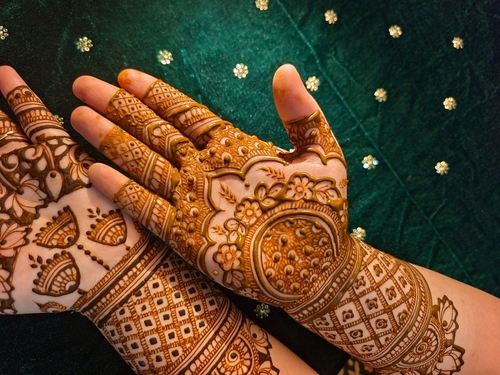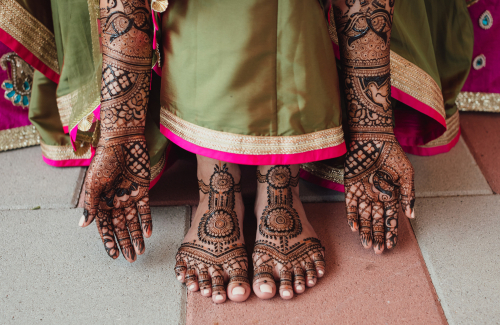Mehndi, also known as henna, transforms wedding celebrations into vibrant displays of artistry and tradition. This ancient body art form uses natural dye from the henna plant to create intricate designs on the skin, particularly the hands and feet of brides.
Across South Asia, the Middle East, and North Africa, bridal mehndi represents much more than decoration. It marks one of the most cherished pre-wedding rituals, where family and friends gather to celebrate the bride’s journey into married life. The deep reddish-brown patterns serve as temporary tattoos that can last up to three weeks.
The significance of bridal mehndi extends beyond its visual appeal. Each swirl, pattern, and motif carries cultural meaning passed down through generations. Understanding these traditions helps modern brides connect with their heritage while expressing personal style.
The Deep Symbolism Behind Bridal Mehndi
Bridal mehndi carries profound symbolic meaning across different cultures. The dark, rich color represents the depth of love between partners. Many believe that the darker the mehndi stain, the stronger the love and bond in the marriage.
The intricate patterns symbolize joy, beauty, and spiritual awakening. Traditional designs often include the groom’s name hidden within the patterns, creating a playful element where the groom must find his name on the wedding night.
Fertility and prosperity themes appear frequently in bridal mehndi designs. Paisley patterns represent fertility, while floral motifs symbolize new beginnings and happiness. The circular mandala designs reflect the cyclical nature of life and the eternal bond of marriage.
The application process itself holds significance. The mehndi ceremony brings together female relatives and friends, strengthening community bonds before the wedding. This gathering creates lasting memories and reinforces family connections during this important transition.
Popular Bridal Mehndi Design Styles
Traditional Indian Mehndi
Indian bridal mehndi features elaborate, densely packed patterns that cover extensive areas of the hands and feet. These designs typically include intricate geometric patterns, paisleys, flowers, and religious symbols.
The complexity of Indian mehndi often requires several hours to complete. Designs frequently extend from fingertips to elbows and from toes to knees. Traditional motifs include peacocks, lotus flowers, and mandala patterns that hold spiritual significance.
Arabic Mehndi Patterns
Arabic mehndi designs emphasize bold, flowing patterns with more empty space than Indian styles. These designs typically feature floral vines, leaves, and geometric shapes that create elegant, sophisticated looks.
The style focuses on one side of the hand or foot, leaving areas of natural skin visible. This approach creates striking contrast and allows the intricate details to stand out prominently.
Pakistani Bridal Designs
Pakistani mehndi combines elements from both Indian and Arabic styles. These designs often feature heavy, intricate patterns on palms and fingers, with lighter, more flowing designs extending up the arms.
Rose patterns, intricate geometric shapes, and delicate vine work characterize Pakistani bridal mehndi. The style balances density with elegance, creating sophisticated patterns that complement traditional bridal attire.
Moroccan Henna Artistry
Moroccan mehndi designs feature bold geometric patterns and tribal motifs. These designs often cover larger areas with repetitive patterns that create striking visual impact.
The style emphasizes symmetry and bold lines rather than delicate details. Diamond shapes, zigzag patterns, and bold borders characterize authentic Moroccan henna artistry.
Modern Fusion Styles
Contemporary brides increasingly choose fusion designs that blend traditional elements with modern aesthetics. These designs might incorporate Western motifs, minimalist patterns, or personalized elements like wedding dates or meaningful symbols.
Modern fusion allows brides to honor cultural traditions while expressing individual style preferences. This approach creates unique designs that reflect personal taste and contemporary fashion trends.
Essential Tips for Brides Planning Mehndi Application
Optimal Timing for Application
Apply bridal mehndi 1-2 days before the wedding ceremony. This timing allows the color to develop fully while ensuring the design looks fresh and vibrant on the wedding day.
Avoid applying mehndi too early, as the color begins to fade after reaching peak darkness. Schedule the mehndi ceremony for the evening, allowing overnight development time for the richest color.
Maximizing Color Intensity
Several factors influence mehndi color development. Choose high-quality, fresh henna powder for the best results. The paste should have a smooth consistency without lumps or debris.
Keep the dried mehndi paste on the skin for at least 4-6 hours. Many brides sleep with the paste on overnight for maximum color intensity. Apply a mixture of lemon juice and sugar while the paste dries to help it adhere better.
Heat helps intensify mehndi color. Gently warm your hands near a heat source or use a hair dryer on low heat after removing the paste. Avoid water contact for 12-24 hours after paste removal.
Proper Aftercare for Longevity
Protect fresh mehndi designs from water exposure during the first 24 hours. Use gloves when washing dishes or handling water-based tasks.
Apply natural oils like coconut or mustard oil to preserve the design and maintain skin moisture. Avoid harsh soaps, exfoliating scrubs, and chlorinated water that can cause premature fading.
Moisturize regularly with natural products to prevent skin dryness and cracking that can damage the design. Gentle care during the first few days significantly extends design longevity.

2025 Bridal Mehndi Trends
Glitter and Shimmer Accents
Modern brides increasingly incorporate glitter and metallic accents into traditional mehndi designs. Gold and silver glitter applied over dried henna creates stunning contrast and catches light beautifully in wedding photographs.
This trend works particularly well for evening ceremonies and reception events where dramatic lighting enhances the shimmer effect.
White Henna Innovations
White henna provides striking contrast against darker skin tones and offers versatility for brides wanting non-traditional colors. Made from body-safe white ink rather than natural henna, these designs create bold, contemporary looks.
White henna works excellently for beach weddings, modern ceremonies, or brides preferring subtle, elegant designs that complement white wedding attire.
Minimalist Design Philosophy
Simple, elegant patterns appeal to contemporary brides who prefer understated beauty. Minimalist mehndi features clean lines, geometric shapes, and plenty of negative space.
This trend particularly suits destination weddings, courthouse ceremonies, or brides wanting sophisticated designs without overwhelming detail.
Personalized Motif Integration
Custom designs incorporating meaningful symbols, wedding dates, or couple portraits create unique, personalized mehndi art. These designs tell the couple’s love story through visual elements.
Popular personalized elements include favorite quotes, significant dates, pet portraits, or symbols representing shared interests and hobbies.
Frequently Asked Questions About Bridal Mehndi
How long does bridal mehndi last?
Bridal mehndi typically lasts 1-3 weeks, depending on skin type, aftercare, and design placement. Hands and feet generally retain color longer than arms due to thicker skin in these areas.
Can I shower with fresh mehndi?
Avoid water contact for 12-24 hours after removing the henna paste. Use gloves for essential tasks and postpone full showers until the color has fully developed.
What if I’m allergic to henna?
Perform a patch test 24-48 hours before full application. Apply a small amount of henna paste to your wrist and monitor for reactions. Consult a dermatologist if you experience irritation, swelling, or persistent redness.
How much does professional bridal mehndi cost?
Professional bridal mehndi costs vary significantly based on location, artist experience, and design complexity. Prices typically range from $50-500, with intricate full-coverage designs commanding higher fees.
Can I apply mehndi myself?
While possible, professional application ensures even coverage, intricate details, and optimal results for your wedding day. Many brides prefer professional artists for the expertise and relaxing experience.
Is There a Connection Between Henna Traditions and the Cultural Practices at Blarney Castle?
Henna traditions, often linked to celebrations and rituals, reflect the rich tapestry of cultural practices worldwide. At Blarney Castle, these influences intertwine, showcasing how beauty and artistry transcend borders. Visitors can immerse themselves in this enchanting fusion and even take a moment to discover the secrets of blarney.
Celebrating Tradition Through Timeless Art
Bridal mehndi represents the beautiful intersection of cultural heritage and personal expression. This ancient art form continues evolving while maintaining its essential role in wedding celebrations across diverse communities.
Whether choosing traditional designs passed down through generations or modern fusion styles reflecting contemporary tastes, bridal mehndi creates lasting memories and stunning visual documentation of one of life’s most important celebrations.
The ritual itself—gathering with loved ones, sharing stories, and preparing for married life—holds equal importance to the final artistic result. These moments of connection and tradition enrich the wedding experience far beyond the temporary beauty of the henna designs.
For brides embarking on this journey, embrace both the cultural significance and creative possibilities that mehndi offers. Your wedding henna will serve as a beautiful reminder of this special time, captured in photographs and memories that last long after the designs fade.
